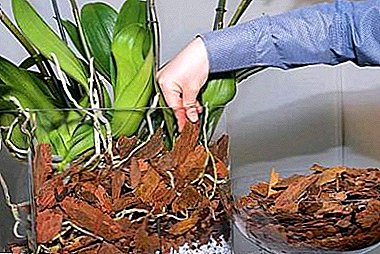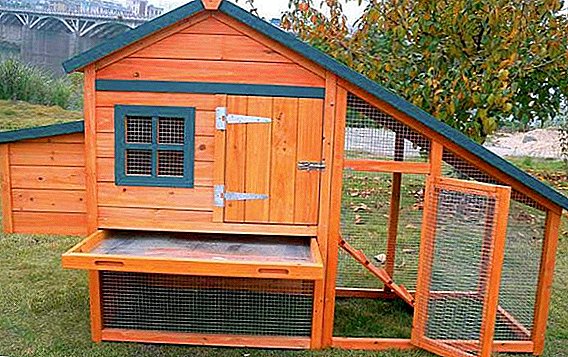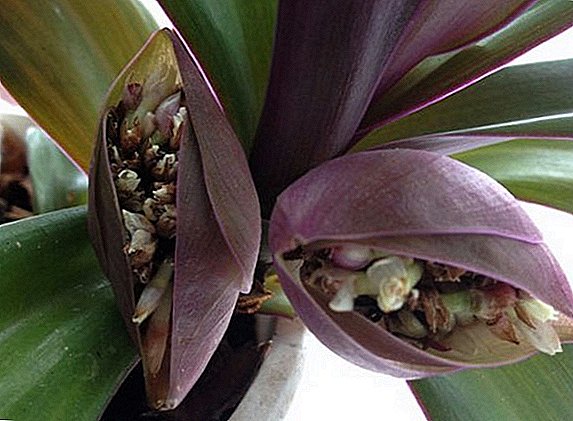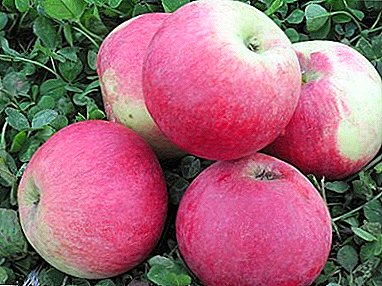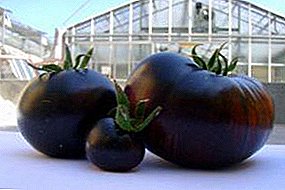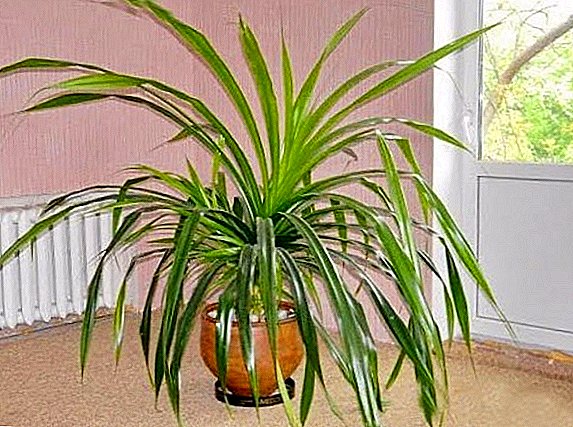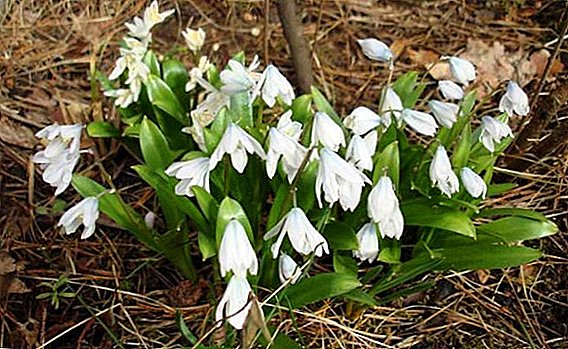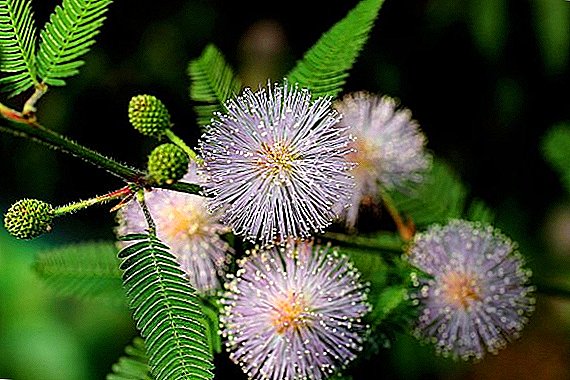 Bashful mimosa refers to plants that are easy to grow, but it takes some effort. It can be grown as an annual and as a perennial plant. But in the latter case, it can greatly stretch out and lose its decorative effect. But from it it is possible to take seeds every year and renew the planting for the next growing season.
Bashful mimosa refers to plants that are easy to grow, but it takes some effort. It can be grown as an annual and as a perennial plant. But in the latter case, it can greatly stretch out and lose its decorative effect. But from it it is possible to take seeds every year and renew the planting for the next growing season.
Did you know? A characteristic feature of the plant is that it folds leaves of a light touch, shaking, strong wind or warming. Scientists called this phenomenon seismmonastia. If you remove the external stimulus, after 20 minutes the sheet opens again. Scientists can not say exactly why the plant has developed such a property. Probably for scaring pests and herbivores.
Flower description mimosa bashful
The plant belongs to the ornamental shrubs, which is home to Brazil, but today it is common in many countries around the world. It belongs to the Mimoz family. The bush has straight stems dotted with spines. It grows on average up to 30-60 cm, but in the natural range, subtropics, it can grow up to 1.5 m.
Important! The plant is poisonous, so make sure that it is not eaten by pets, and be careful with it.
 The whole plant is covered with whitish fluffy hairs. Sensitive leaves are bicensed, closed not only by touch, but also at night. Flowers of lilac or pink color are collected in globular inflorescences. Pollinated by insects or wind, and then form the fruit - the pods, which are 2-8 peas.
The whole plant is covered with whitish fluffy hairs. Sensitive leaves are bicensed, closed not only by touch, but also at night. Flowers of lilac or pink color are collected in globular inflorescences. Pollinated by insects or wind, and then form the fruit - the pods, which are 2-8 peas.Optimal conditions for growing shy mimosa
In our strip of mimosa, bashful is grown from seeds and cultivated as a houseplant. The success of cultivation depends on the correctly chosen conditions.
Lighting
The plant is light-loving, therefore it should be placed on the south side, choosing the brightest place in the room. Some amount of direct sunlight during the day is acceptable.
Important! During flowering and after the fall of the inflorescences from the plant in the air a large amount of pollen spreads, which is considered a high allergen. People who are prone to seasonal allergies are not recommended to grow a bashful mimosa flower at home.In winter, due to the lack of light, the bashful mimosa can stretch out and lose its decorative properties. In this case, in the spring it can be strongly trimmed, and over the summer it will restore its appearance. But it is better to prevent this by organizing additional lighting in the winter.
Temperature
 The ideal temperature at which a flower develops well is 20-24 ° C. This rule applies to the summer period when the plant actively grows and forms flowers, fruits. In winter, in the dormant period, bashful mimosa should be kept at room temperature not lower than 16 ° C.
The ideal temperature at which a flower develops well is 20-24 ° C. This rule applies to the summer period when the plant actively grows and forms flowers, fruits. In winter, in the dormant period, bashful mimosa should be kept at room temperature not lower than 16 ° C.
Peculiarities of care for mimosa shy at home
Mimosa bashful unpretentious in the care at home. If you follow all the recommendations described below, it will delight you with bloom for four months.
Important! The flower is extremely sensitive to tobacco smoke. One contact is enough to make a bashful mimosa throw off all the leaves.
Watering and humidity
If you have a mimosa in your house, care and cultivation start with the proper watering of the plant. Starting from spring to autumn, it requires abundant watering, but so that the water in the pot does not stagnate. In winter, during the period of rest, the number of waterings should be reduced to about once a week. It is necessary to use only soft water.
 The flower loves high humidity, about 75-85%. It is especially difficult to maintain such indicators in the winter when the humidity drops sharply during operation of the central heating. That is why in the rest period mimosa often dies. To avoid this, it is recommended to put a bowl of water next to it or spray it.
The flower loves high humidity, about 75-85%. It is especially difficult to maintain such indicators in the winter when the humidity drops sharply during operation of the central heating. That is why in the rest period mimosa often dies. To avoid this, it is recommended to put a bowl of water next to it or spray it.
Important! It is necessary to spray only the air around the plant. If the drops fall on the leaves of mimosa, she immediately folded them.
Soil and fertilizer
For the cultivation of shy in mimosa pot almost any soil for ornamental plants will do. It should be loose, nutritious, but contain as little peat as possible. The mixture can be prepared independently, taking a part of peat, part of hardwood, two parts of clay-soddy soil and half of the sand.
The plant must be regularly fed, especially during the period of active development and flowering. It is ideal to feed during the growing season about once a week. It is enough to use a special liquid fertilizer for ornamental plants.
Did you know? The movement of the leaves of the plant over time is noticed. The first to discover and record this phenomenon was the French astronomer De Meyren in 1729. The movements were called niktinastiya. They have a certain frequency, and they are not affected by the light. It is assumed that the movements are associated with the biorhythms of the Earth. The Swiss biogeograph and botanist Alphonse Decandol in 1832, through experiments, proved that these movements are carried out at intervals of 22-23 hours.
 The soil of the bashful mimosa must be periodically loosened, but otherwise the question of how to care for the plant is solved the same way as with other ornamental plants. The only thing, it is necessary to replant the plant after wintering, and also as needed during the growing season: in the process of treatment or in the case of soil rotting.
The soil of the bashful mimosa must be periodically loosened, but otherwise the question of how to care for the plant is solved the same way as with other ornamental plants. The only thing, it is necessary to replant the plant after wintering, and also as needed during the growing season: in the process of treatment or in the case of soil rotting.Difficulties in growing: diseases and pests mimosa bashful
The flower is less prone to disease. Most often, he manifests such a disease as withering leaves. This is usually due to lack of moisture. Solve the question will help spraying the air around the plant and the regularity of watering.
If the air is too dry, a spider mite can attack the plant. Then, in addition to leveling off the air humidity, mimosa should be treated with acaricides of the type Actellic, Sunmite, Omite. In the same conditions may appear aphid. To combat it you need to use systemic insecticides.
Growing mimosa bashful of seeds at home
 Reproduces the plant not only seeds. You can use the cuttings, but they have a low percentage of rooting. therefore it is safer to use the first method, especially since mimosa seeds germinate quickly. You can buy them in the store, and if you already have an adult plant, you need to pollinate it and wait for the fruit to start. When the pods are completely dry, they are collected and folded in a paper bag that is stored on the door of the refrigerator.
Reproduces the plant not only seeds. You can use the cuttings, but they have a low percentage of rooting. therefore it is safer to use the first method, especially since mimosa seeds germinate quickly. You can buy them in the store, and if you already have an adult plant, you need to pollinate it and wait for the fruit to start. When the pods are completely dry, they are collected and folded in a paper bag that is stored on the door of the refrigerator.
Sowing is carried out in late February - early April. They take out seeds from the pods and fill them with hot water for half an hour. Tanks for planting fill disinfected and wetted loose soil. The seeds are immersed in it at a depth of about a centimeter. Crops are covered with polyethylene or glass and placed in a warm place so that direct sunlight does not fall on it. The air temperature should not be below 20 ° C, and preferably around 25 ° C.
The first shoots should appear in a couple of weeks, but more often they make their way in a month. It all depends on how favorable conditions are organized for the growth of mimosa. When the sprouts reach 5 cm, the seedlings are transplanted into separate cups. In May - June, when they will be already for 2 - 3 months, they are planted in a permanent place. Further care is organized as for an adult plant.
Did you know? Florists recommend growing several plants in one pot. So you can achieve greater decoration. Over time, they may need support.
 Mimosa bashful has a high decorative effect, so many wonder how to grow such a plant at home. Sprouting seeds and caring for seedlings will not cause any difficulties. But caring for an adult flower has some peculiarities. They are associated with the properties of the plant itself, which folds the leaves as soon as something touches it.
Mimosa bashful has a high decorative effect, so many wonder how to grow such a plant at home. Sprouting seeds and caring for seedlings will not cause any difficulties. But caring for an adult flower has some peculiarities. They are associated with the properties of the plant itself, which folds the leaves as soon as something touches it.therefore you need to try to touch him as little as possible, not to be zealous with transfers. Otherwise, it is enough to keep the mimosa in a bright room, to withstand an air temperature of about 25 ° C and to water it abundantly. And then the plant will delight fluffy pink buds for four months. Of the pests should fear only aphids and spider mites. But while maintaining the proper level of humidity, they are unlikely to appear.


